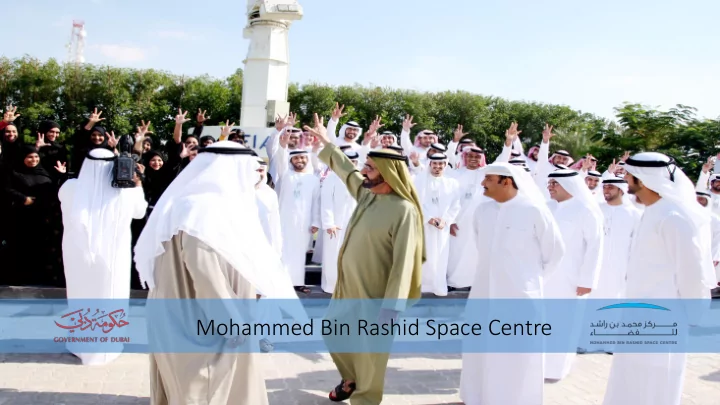

Mohammed Bin Rashid Space Centre
Space in the UAE Today • The UAE is one of the most ambitious countries in space and is a major player in the Gulf and Arab Word • The UAE is very active and is developing: • Interplanetary missions • Geostationary satellite communications • Remote sensing missions • Educational missions • The UAE is developing the infrastructure necessary to have a sustainable space programme in the country
Space in the UAE Today • The UAE space programme is diverse and includes: Government: Commercial/Private: Universities:
Introduction to MBRSC • Emirates Institution for Advanced Science and Technology (EIAST) was established in February 2006. • On April 18th, 2015: a decree has been issued to incorporate EIAST in the newly established: Mohamed Bin Rashid Space Center (M (MBR BRSC) ) • Main Goal: “Nationalize the development of space systems and contribute to the field internationally”
DubaiSat-1 & DubaiSat-2 Missions Main Objectives: • Tech and Know-How Transfer for satellite Development • Continuous Manpower Development • Meeting the continuous need of spatial information and EO data of the UAE DubaiSat-1 DubaiSat-2 Altitude (km) 680 600 Mass ~ 200 kg < 300 Kg Spatial Resolution PAN 2.5m, MS 5m PAN 1M, MS 4m Data Quantization 8-bits 10-bits Mass Storage 64 Gbits 256 Gbits Imaging Modes Single Strip Single Strip Fast Multi-Strip Single Pass Stereo Data Download Speed 30Mbps 160Mbps Swath Width (km) 20 12 29 th July 2009 21 st Nov 2013 Launch date
KhalifaSat • KhalifaSat is MBRSC’s 3rd Earth Observation Satellite. • 100 engineers working on it • The four year programme to develop KhalifaSat began in 2013. • 0.70 cm resolution • Signed launch agreement with Mitsubishi Heavy Industries, Ltd (MHI); to launch KhalifaSat together with GOSAT-2 onboard H-IIA launch vehicle in Q1 2018. • Current Status: Manufacturing Flight Model, should be completed by Q3 2017.
Emirates Mars Mission: Al-Amal Probe • The UAE Space Agency and MBRSC signed an agreement in October 20th, 2014; to build the first Arabic-Islamic Mars space probe. • Strategic Objective: “to build Emirati technical and intellectual capabilities in the fields of aerospace and space exploration to make use of space technology in a way that enhances the country’s development plans” • Scientific Objective: “EMM will, for the first time, explore the dynamics in the atmosphere of Mars on a global scale. It will provide holistic, global and diurnal understanding of the atmospheric dynamics of Mars • Current Status: CDR in May Programme Partners:
MBRSC Facilities • Completed Phase 1 and 2 which comprise a clean room for the manufacture of satellites, an electrical laboratory, a mechanical lab and the high-bay area. • MBRSC Manufacturing Facility can accommodate all manufacturing activities for our earth observation satellites and the Emirates Mars Mission. • Phase 3 will include the complete satellite testing facilities that will be operational by 2019
New Actors in Space • What is the rationale for emerging Space Programmes, specifically the UAE? • Why is the UAE investing over 5 billion USD in its Space Activities? • Economic diversity • Post oil economy • Education and outreach • National capability development through Technology and knowhow transfer • SME eco system development around government space programme • Manufacturing taking place in the UAE • Creating high tech jobs • National pride
New Actors in Space • Challenges and opportunities facing new actors? • Challenges : • Technology transfer restrictions • Export licenses and ITAR • Private sector partnership – TRUE partnership, linked to the first two points • Space debris – more small sats, more congestions = space security and sustainability issues which can = more restrictions or resistance to these activities by emerging space players • Cooperation in-between emerging state actors is lacking
New Actors in Space • Challenges and opportunities facing new actors? • Opportunities : • Successful technology transfer programmes can promote best practices in the space domain • Usually starting later and can learn from the success and failures that came before. • Cooperation can increase the benefits to all, we would be able to achieve larger more expensive projects eg ISS 2.0 with emerging nations participation • New space entities have many synergies with emerging government space actors and this can be an opportunity for both • In the UAE’s case we are open to cooperate with all nations which can speed up our activities and goals
In summary • Emerging and established actors need to agree on what constitutes acceptable behavior in space, or their combined activities may threaten the long term usage of space. • Cooperation and partnerships are very helpful to support best practices and support the responsible use of outer space as they build trust and strong relationships • A Question: The UAE’s mars 2117 plan, could this be the start of an ISS 2.0? Could this be a partnership of all nations new and old?
Thank you!
Recommend
More recommend